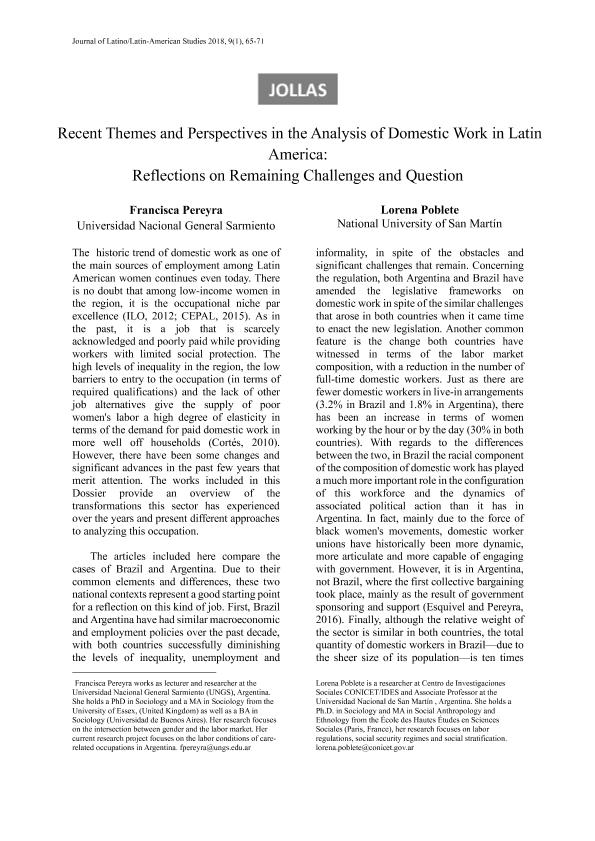Artículo
Recent Themes and Perspectives in the Analysis of Domestic Work in Latin America: Reflections on Remaining Challenges and Question
Fecha de publicación:
01/2018
Editorial:
University of Nebraska
Revista:
Journal of Latino
ISSN:
1549-9502
Idioma:
Inglés
Tipo de recurso:
Artículo publicado
Clasificación temática:
Resumen
The historic trend of domestic work as one of the main sources of employment among Latin American women continues even today. There is no doubt that among low-income women in the region, it is the occupational niche par excellence (ILO, 2012; CEPAL, 2015). As in the past, it is a job that is scarcely acknowledged and poorly paid while providing workers with limited social protection. The high levels of inequality in the region, the low barriers to entry to the occupation (in terms of required qualifications) and the lack of other job alternatives give the supply of poor women´s labor a high degree of elasticity in terms of the demand for paid domestic work in more well-off households (Cortés, 2010). However, there have been some changes and significant advances in the past few years that merit attention. The works included in this Dossier provide an overview of the transformations this sector has experienced over the years and present different approaches to analyzing this occupation. The articles included here compare the cases of Brazil and Argentina. Due to their common elements and differences, these two national contexts represent a good starting point for a reflection on this kind of job. First, Brazil and Argentina have had similar macroeconomic and employment policies over the past decade, with both countries successfully diminishing the levels of inequality, unemployment and informality, in spite of the obstacles and significant challenges that remain. Concerning the regulation, both Argentina and Brazil have amended the legislative frameworks on domestic work in spite of the similar challenges that arose in both countries when it came time to enact the new legislation. Another common feature is the change both countries have witnessed in terms of the labor market composition, with a reduction in the number of full-time domestic workers. Just as there are fewer domestic workers in live-in arrangements (3.2% in Brazil and 1.8% in Argentina), there has been an increase in terms of women working by the hour or by the day (30% in both countries). With regards to the differences between the two, in Brazil the racial component of the composition of domestic work has played a much more important role in the configuration of this workforce and the dynamics of associated political action than it has in Argentina. In fact, mainly due to the force of black women´s movements, domestic worker unions have historically been more dynamic, more articulate and more capable of engaging with government. However, it is in Argentina, not Brazil, where the first collective bargaining took place, mainly as the result of government sponsoring and support (Esquivel and Pereyra, 2016). Finally, although the relative weight of the sector is similar in both countries, the total quantity of domestic workers in Brazil, due to the sheer size of its population, is ten times higher than that of Argentina (ILO, 2013), thus suggesting greater complexities and challenges in terms of implementing policies aimed at this sector. This text, which offers a sort of summary of the different works included the Dossier, proposes to examine certain points in common between the different situations and trends analyzed in the articles. The aim is to reflect on approaches that appear particularly useful along with the challenges and questions posed by the set of works included here.
Archivos asociados
Licencia
Identificadores
Colecciones
Articulos(CIS)
Articulos de CTRO.DE INVESTIGACIONES SOCIALES
Articulos de CTRO.DE INVESTIGACIONES SOCIALES
Citación
Pereyra, Francisca; Poblete, Lorena Silvina; Recent Themes and Perspectives in the Analysis of Domestic Work in Latin America: Reflections on Remaining Challenges and Question; University of Nebraska; Journal of Latino; 9; 1; 1-2018; 65-71
Compartir
Altmétricas




